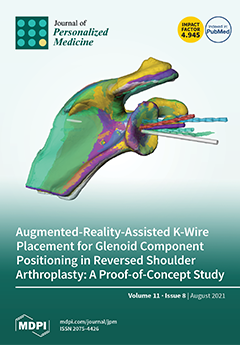The aim of our study was to determine the impact of unsupervised Pulmonary Rehabilitation (uns-PR) on patients recovering from COVID-19, and determine its anthropometric, biological, demographic and fitness correlates. All patients (
n = 20, age: 64.1 ± 9.9 years, 75% male) participated in unsupervised Pulmonary Rehabilitation program for eight weeks. We recorded anthropometric characteristics, pulmonary function parameters, while we performed 6 min walk test (6 MWT) and blood sampling for oxidative stress measurement before and after uns-PR. We observed differences before and after uns-PR during 6 MWT in hemodynamic parameters [systolic blood pressure in resting (138.7 ± 16.3 vs. 128.8 ± 8.6 mmHg,
p = 0.005) and end of test (159.8 ± 13.5 vs. 152.0 ± 12.2 mmHg,
p = 0.025), heart rate (5th min: 111.6 ± 16.9 vs. 105.4 ± 15.9 bpm,
p = 0.049 and 6th min: 112.5 ± 18.3 vs. 106.9 ± 17.9 bpm,
p = 0.039)], in oxygen saturation (4th min: 94.6 ± 2.9 vs. 95.8 ± 3.2%,
p = 0.013 and 1st min of recovery: 97.8 ± 0.9 vs. 97.3 ± 0.9%), in dyspnea at the end of 6 MWT (1.3 ± 1.5 vs. 0.6 ± 0.9 score,
p = 0.005), in distance (433.8 ± 102.2 vs. 519.2 ± 95.4 m,
p < 0.001), in estimated O
2 uptake (14.9 ± 2.4 vs. 16.9 ± 2.2 mL/min/kg,
p < 0.001) in 30 s sit to stand (11.4 ± 3.2 vs. 14.1 ± 2.7 repetitions,
p < 0.001)] Moreover, in plasma antioxidant capacity (2528.3 ± 303.2 vs. 2864.7 ± 574.8 U.cor.,
p = 0.027), in body composition parameters [body fat (32.2 ± 9.4 vs. 29.5 ± 8.2%,
p = 0.003), visceral fat (14.0 ± 4.4 vs. 13.3 ± 4.2 score,
p = 0.021), neck circumference (39.9 ± 3.4 vs. 37.8 ± 4.2 cm,
p = 0.006) and muscle mass (30.1 ± 4.6 vs. 34.6 ± 7.4 kg,
p = 0.030)] and sleep quality (6.7 ± 3.9 vs. 5.6 ± 3.3 score,
p = 0.036) we observed differences before and after uns-PR. Our findings support the implementation of unsupervised pulmonary rehabilitation programs in patients following COVID-19 recovery, targeting the improvement of many aspects of long COVID-19 syndrome.
Full article






